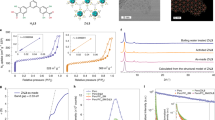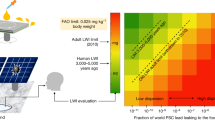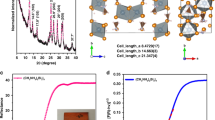Abstract
Perovskite solar cells (PSCs) as an emerging renewable energy technology are expected to play an important role in the transition to a sustainable future. However, lead toxicity of PSCs remains a major flaw hindering their large-scale implementation and compromising their sustainability, as lead is currently inevitable in making high-performance PSCs. Here we show that this can be addressed by embedding a cross-linking supramolecular complex composed of 2-hydroxypropyl β-cyclodextrin (HPβCD) and 1,2,3,4-butane tetracarboxylic acid (BTCA). The built-in HPβCD-BTCA complex can largely inhibit lead leakage from severely damaged PSCs, which retain 97% of the initial efficiency after 522 h dynamic water scouring, with only <14 ppb lead contamination in water. Toxicity evaluation implies that the chelation between HPβCD-BTCA complex and lead-bearing perovskites can also reduce the toxicity of lead-bearing PSCs to the comparable or even lower level than their lead-free counterparts. Moreover, the HPβCD-BTCA incorporation simultaneously improves the stability and reproducibility of PSCs. The proposed strategy paves a new avenue for sustainable PSCs and can move PSCs closer to commercial implementation.
This is a preview of subscription content, access via your institution
Access options
Access Nature and 54 other Nature Portfolio journals
Get Nature+, our best-value online-access subscription
$29.99 / 30 days
cancel any time
Subscribe to this journal
Receive 12 digital issues and online access to articles
$119.00 per year
only $9.92 per issue
Buy this article
- Purchase on Springer Link
- Instant access to full article PDF
Prices may be subject to local taxes which are calculated during checkout





Similar content being viewed by others
Data availability
The data that support the findings of this study are available within the Article and its Supplementary Information files and from the corresponding author upon reasonable request. Source data are provided with this paper.
References
Best Research-Cell Efficiency Chart (National Renewable Energy Laboratory, 2023); https://www.nrel.gov/pv/cell-efficiency.html
Jung, E. H. et al. Efficient, stable and scalable perovskite solar cells using poly(3-hexylthiophene). Nature 567, 511–515 (2019).
Correa-Baena, J.-P. et al. Promises and challenges of perovskite solar cells. Science 358, 739–744 (2017).
Yang, W. S. et al. Iodide management in formamidinium-lead-halide-based perovskite layers for efficient solar cells. Science 356, 1376–1379 (2017).
Jeong, M. et al. Stable perovskite solar cells with efficiency exceeding 24.8% and 0.3 V voltage loss. Science 369, 1615–1620 (2020).
Jeong, J. et al. Pseudo-halide anion engineering for α-FAPbI3 perovskite solar cells. Nature 592, 381–385 (2021).
Yoo, J. J. et al. Efficient perovskite solar cells via improved carrier management. Nature 590, 587–593 (2021).
Rong, Y. et al. Challenges for commercializing perovskite solar cells. Science 361, eaat8235 (2018).
Rajagopal, A., Yao, K. & Jen, A. K.-Y. Toward perovskite solar cell commercialization: a perspective and research roadmap based on interfacial engineering. Adv. Mater. 30, 1800455 (2018).
Li, X. On-device lead-absorbing tapes for sustainable perovskite solar cells. Nat. Sustain. 4, 1038–1041 (2021).
Xiao, X. et al. Lead-adsorbing ionogel-based encapsulation for impact-resistant, stable, and lead-safe perovskite modules. Sci. Adv. 7, eabi8249 (2021).
Hu, Y. et al. Dual functions of performance improvement and lead leakage mitigation of perovskite solar cells enabled by phenylbenzimidazole sulfonic acid. Small Methods 6, 2101257 (2022).
Chen, S. et al. Trapping lead in perovskite solar modules with abundant and low-cost cation-exchange resins. Nat. Energy 5, 1003–1011 (2020).
Chen, S. et al. Preventing lead leakage with built-in resin layers for sustainable perovskite solar cells. Nat. Sustain. 4, 636–643 (2021).
Zhang, H. et al. Design of superhydrophobic surfaces for stable perovskite solar cells with reducing lead leakage. Adv. Energy Mater. 11, 2102281 (2021).
Meng, X. et al. A biomimetic self-shield interface for flexible perovskite solar cells with negligible lead leakage. Adv. Funct. Mater. 31, 2106460 (2021).
Wu, P. et al. Beyond efficiency fever: preventing lead leakage for perovskite solar cells. Matter 5, 1137–1161 (2022).
Gao, Y. et al. Recent advances in lead-safe perovskite solar cells. Adv. Funct. Mater. 32, 2208225 (2022).
Li, X. et al. On-device lead sequestration for perovskite solar cells. Nature 578, 555–558 (2020).
Chen, J. et al. Managing lead leakage in efficient perovskite solar cells with phosphate interlayers. Adv. Mater. Interfaces 9, 2200570 (2022).
Liu, S. et al. Pseudo-planar heterojunction organic photovoltaics with optimized light utilization for printable solar windows. Adv. Mater. 34, 2201604 (2022).
Chen, S. et al. A holistic sunscreen interface strategy to effectively improve the performance of perovskite solar cells and prevent lead leakage. Chem. Eng. J. 433, 134566 (2022).
Wang, F. et al. Supramolecular bridging strategy enables high performance and stable organic-inorganic halide perovskite solar cells. Chem. Eng. J. 446, 137431 (2022).
Lee, J. et al. Nonaromatic green-solvent-processable, dopant-free, and lead-capturable hole transport polymers in perovskite solar cells with high efficiency. Adv. Energy Mater. 10, 1902662 (2020).
Liang, Y. et al. Lead leakage preventable fullerene-porphyrin dyad for efficient and stable perovskite solar cells. Adv. Funct. Mater. 32, 2110139 (2022).
Niu, B. et al. Mitigating the lead leakage of high-performance perovskite solar cells via in situ polymerized networks. ACS Energy Lett. 6, 3443–3449 (2021).
Park, S. Y. et al. Sustainable lead management in halide perovskite solar cells. Nat. Sustain. 3, 1044–1051 (2020).
Wang, X. et al. Sustainable management of lead in perovskite solar cells. J. Mater. Chem. A 10, 15861–15864 (2022).
Chen, B. et al. Recycling lead and transparent conductors from perovskite solar modules. Nat. Commun. 12, 5859 (2021).
Wu, W. et al. Blading phase-pure formamidinium-alloyed perovskites for high-efficiency solar cells with low photovoltage deficit and improved stability. Adv. Mater. 32, 2000995 (2020).
Alsbaiee, A. et al. Rapid removal of organic micropollutants from water by a porous β-cyclodextrin polymer. Nature 529, 190–194 (2016).
Chen, C. et al. Stabilizing formamidinium lead iodide perovskite precursor solution with phenylboric acid. Sol. RRL 5, 2000715 (2021).
Li, J. et al. An effective and economical encapsulation method for trapping lead leakage in rigid and flexible perovskite photovoltaics. Nano Energy 93, 106853 (2022).
Luo, D. et al. Minimizing non-radiative recombination losses in perovskite solar cells. Nat. Rev. Mater. 5, 44–60 (2020).
Wang, F. et al. Iodine-assisted antisolvent engineering for stable perovskite solar cells with efficiency >21.3 %. Nano Energy 67, 104224 (2020).
Martwong, E., Sukhawipat, N. & Junthip, J. Cotton cord coated with cyclodextrin polymers for paraquat removal from water. Polymers 14, 2199 (2022).
Yang, C. Q., Lu, Y. & Lickfield, G. C. Chemical analysis of 1,2,3,4-butanetetracarboxylic acid. Text. Res. J. 72, 817–824 (2002).
Liu, P. et al. Study on the toxic effect of lead(II) ion on Escherichia coli. Biol. Trace Elem. Res. 115, 195–202 (2007).
Feng, X. et al. Close-loop recycling of perovskite solar cells through dissolution-recrystallization of perovskite by butylamine. Cell Rep. Phys. Sci. 2, 100341 (2021).
Tan, Y. et al. Chemical linkage and passivation at buried interface for thermally stable inverted perovskite solar cells with efficiency over 22%. CCS Chem. 1–13 (2022).
Schmidt, F. et al. Organic solvent free PbI2 recycling from perovskite solar cells using hot water. J. Hazard. Mater. 447, 130829 (2023).
Song, T. et al. Comprehensive performance calibration guidance for perovskites and other emerging solar cells. Adv. Energy Mater. 11, 2100728 (2021).
Zhao, Y. et al. Perovskite seeding growth of formamidinium-lead-iodide-based perovskites for efficient and stable solar cells. Nat. Commun. 9, 1607 (2018).
Acknowledgements
We acknowledge financial support from the National Key R&D Program of China (grant number 2019YFB1503200), the National Natural Science Foundation of China (grant number 22005355 to W.-Q. W.), Guangdong Basic and Applied Basic Research Foundation (grant number 2022A1515010282 to W.-Q.W.) and State Key Laboratory of Advanced Technology for Materials Synthesis and Processing (Wuhan University of Technology).
Author information
Authors and Affiliations
Contributions
W.-Q.W. supervised this work. W.-Q.W. conceived the idea and designed the experiments. M.Y. and T.T. investigated the cross-linking mechanism and fabricated the thin films and devices. M.Y. carried out the characterization of materials and the Pb leakage test. M.Y., Y.F. and G.L. performed the XRD, XPS and transient absorption study. W.-G.L. and M.Y. conducted the spectral corrections, temperature-dependent PL and TRPL measurements. Y.F. and W.F. performed the thick-film devices fabrication and measurement. M.Y., M.X., T.T. and Y.F. investigated the biocompatibility of the HPβCD-BTCA-modified perovskite films and the Pb toxicity. W.-Q.W. and M.Y. wrote the first draft of the manuscript, and all authors discussed the results and reviewed the manuscript.
Corresponding author
Ethics declarations
Competing interests
The authors declare no competing interests.
Peer review
Peer review information
Nature Sustainability thanks Tao Xu and the other, anonymous, reviewer(s) for their contribution to the peer review of this work.
Additional information
Publisher’s note Springer Nature remains neutral with regard to jurisdictional claims in published maps and institutional affiliations.
Supplementary information
Supplementary Information
Supplementary Figs. 1–45, Discussion and Table 1.
Supplementary Video 1
Broken PSCs under dynamic water scouring.
Supplementary Video 2
J–V testing of broken PSCs under dynamic water scouring.
Source data
Source Data Fig. 1
Statistical source data.
Source Data Fig. 2
Statistical source data.
Source Data Fig. 3
Statistical source data.
Source Data Fig. 4
Statistical source data.
Source Data Fig. 5
Statistical source data.
Rights and permissions
Springer Nature or its licensor (e.g. a society or other partner) holds exclusive rights to this article under a publishing agreement with the author(s) or other rightsholder(s); author self-archiving of the accepted manuscript version of this article is solely governed by the terms of such publishing agreement and applicable law.
About this article
Cite this article
Yang, M., Tian, T., Fang, Y. et al. Reducing lead toxicity of perovskite solar cells with a built-in supramolecular complex. Nat Sustain 6, 1455–1464 (2023). https://doi.org/10.1038/s41893-023-01181-x
Received:
Accepted:
Published:
Issue Date:
DOI: https://doi.org/10.1038/s41893-023-01181-x
This article is cited by
-
Desirable candidates for high-performance lead-free organic–inorganic halide perovskite solar cells
Materials for Renewable and Sustainable Energy (2024)
-
Multifunctional MOF@COF Nanoparticles Mediated Perovskite Films Management Toward Sustainable Perovskite Solar Cells
Nano-Micro Letters (2024)
-
Preventing lead release from perovskites
Nature Sustainability (2023)



